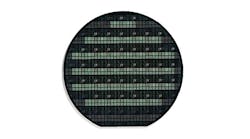Market research firm Yole Développement’s new “Power GaN Market” report forecasts a $600 million market for gallium-nitride (GaN) devices by 2020, which translates to approximately 580,000 six-inch wafers. Dr. Philippe Roussel, Yole’s business unit senior manager, says that starting in 2016, compound annual growth rate (CAGR) will be an estimated 80% through 2020, based on the assumption that electric vehicle/hybrid electric vehicles (EVs/HEVs) will begin adopting GaN during the 2018-2019 timeframe.
When asked about GaN’s role in the EV/HEV arena, auto manufacturers responded positively, saying that despite the long qualification time (slowing time to market), EVs/HEVs offer a good landing spot for the technology. Car makers will target dc-dc converters at the outset, and consider using GaN for battery chargers. Still, it’s unclear at this point whether GaN can withstand the 80-kW power required in EVs/HEVs.
The power-supply/power-factor-correction (PFC) segment is expected to dominate the GaN market from 2015-2018, accounting for 50% of device sales. Yole says that by the time that segment’s “streak” is over, automotive will likely catch up.
“The market is huge and represents a very small fraction of business,” says Roussel. “But, when done in Yole Développement’s cost simulation with GaN solution, it worked very well. GaN will save money because it will reduce the amount of devices used by allowing you to perform a function at a higher frequency.”
Payback time for GaN is about six months, with PFC being a little more expensive at the start. Subsequently, however, the cost could reduce, saving 1-2% in terms of efficiency. GaN technology will also likely take a 15% marketshare in UPS applications by 2020.
For motor-drive applications, automakers are unlikely to assume extra costs. Thus, incentives to implement new technologies like GaN must be strong. Due to the possible improvement of conversion efficiency, and bolstered by anticipated price parity with silicon solutions by 2018, the report expects GaN’s implementation in motor control to start gradually in 2015-2016, reaching $45 million by 2020.
Roussel weighed in on the affect GaN will have on silicon carbide (SiC) due to its better price positioning: “GaN will obviously replace SiC, and SiC will naturally move to a higher voltage. At 600 V, GaN has a greater chance and as soon as 600 V GaN is ready and qualified, the displacement will happen within one to two years.”
The outlook for many GaN companies in the next one-and-a-half to two years does not look good—2014 will generate only $10 million to $12 million in device sales, meaning that only the strongest companies will survive in the early years of GaN application. By 2016, though, the GaN business is expected to gain momentum, exceeding the “psychological threshold” of $50 million in revenue.
Pushing past all of the anticipated mergers, acquisitions, and licensing agreements will spur that momentum, and ultimately shape the GaN industry. One such example is the latest Transphorm-Fujitsu agreement—a sign that GaN is spreading through the value chair and strengthening leaders’ market position. Semiconductor Today reported on the integration of GaN devices:
Device makers worldwide are competing to commercialize GaN power devices. While Transphorm has already released what it claims are the first qualified high-voltage commercial GaN devices, the company continues to make significant improvements in performance, quality and productivity. Given this, Fujitsu, Fujitsu Semiconductor and Transphorm will bring together their complementary strengths in technology and manufacturing to enable GaN power device solutions to be delivered quickly to the market with both scale and affordability.
The new report features a bill-of-materials comparison of GaN against silicon at system levels and a payback-time simulation. Data is included for many application areas over the 2013-2020 time period, such as EV/HEV inverters, wind turbines, rail traction, motor drives, and PV inverters.
